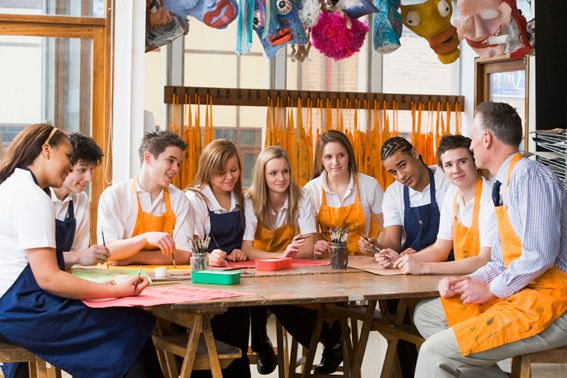Personalized Art Programs for Every Interest
- Sharon

- Jun 18
- 4 min read
Creating art can be a rewarding experience for individuals of all ages and abilities. Personalized art programs cater to unique interests, skills, and desires, allowing everyone to find their voice in the artistic realm. Whether you are a budding artist or a seasoned creator, these tailor-made programs offer something valuable for every individual.
Personalized Art Programs
Personalized art programs take your specific interests and skills into account. They cater to artists who want to explore new styles, improve techniques, or even dive into a completely different medium. According to a survey by the National Endowment for the Arts, participation in tailored art programming can increase one's self-esteem and social engagement.
These programs provide structured guidance while allowing for the freedom of creativity. For example, a painter interested in abstract artwork can enroll in a program focusing solely on modern techniques. Additionally, someone drawn to pottery can find workshops that emphasize functional pieces versus purely decorative items.

Diverse Interest Areas
When developing a personalized art program, it's essential to consider the various interest areas available. Artists may choose from a wide range of disciplines, including painting, drawing, sculpture, photography, and mixed media. Each field offers unique opportunities for exploration and expression.
For instance, in painting, individuals can choose from watercolor, acrylic, or oil mediums. Drawing programs might include graphite, charcoal, or colored pencil techniques. Sculpture classes may involve clay, metal, or wood, while photography courses can delve into digital, film, or alternative methods.
A well-structured program will assess one’s current skill level and help them set achievable goals. Those just starting may focus on the basics, while more experienced artists can dive right into complex projects.

Interactive and Engaging Learning
Personalized art programs prioritize interactive learning experiences. This may include engaging in hands-on workshops, participating in collaborative projects, or receiving one-on-one mentorship. A strong emphasis on community fosters a supportive environment, encouraging participants to share ideas and receive constructive feedback.
Research from the American Art Therapy Association demonstrates that interactive art-making enhances emotional well-being. Programs that facilitate group activities or showcase students’ artwork create a sense of belonging and provide motivation. Think about community art classes where students can display their work and network with local artists, encouraging continuous growth.
These interactive elements can take many forms, such as:
Workshops: Short, intensive sessions focusing on specific techniques or styles.
Art Challenges: Encouraging participants to create within certain themes or constraints.
Exhibitions: Showcasing the work of students to promote dialogue and feedback.
Special Interest Programs
Some individuals may have particularly niche interests that require specialized programs. For instance, children fascinated by nature may benefit from art courses centered around botanical illustration or environmental themes. Alternatively, those with a passion for history might engage in programs exploring historical art movements or crafting replicas of iconic pieces.
Programs like this can provide context and inspiration, guiding students through discussions about the personal significance of their interests. Participants can explore how their hobbies align with historical or cultural influences, adding an enriching layer to their artistic journey.

Choosing the Right Personalized Art Program
When selecting a personalized art program, consider the following factors:
Goals: Define what you want to achieve—improving skills, exploring new techniques, or simply having fun.
Instructor Experience: Look for instructors with specialized knowledge in the desired medium or style.
Class Size: Smaller class sizes typically offer more personalized attention and feedback.
Flexibility: Choose a program that allows you to adapt your learning based on your pace and interests.
Research and read reviews before committing to a program. Ask questions to gauge whether the program aligns with your artistic aspirations.
The Beauty of Customization
At a time when expressiveness is vital, personalization in art affirms the power of creativity. Programs can range from short workshops to long-term mentorships. Students can typically choose how often they want to meet, creating flexibility in their schedules. Whether you attend classes weekly or opt for a more intensive summer workshop, options abound.
For example, art ala carte offers personalized art programs tailored to diverse interests and skill levels, providing quality instruction and creative freedom. Their program selection ensures that participants can explore their artistic passions and find the perfect outlet for expression.
Exploring New Mediums and Techniques
Every artist reaches a point where they wish to experiment and step outside their comfort zone. Customized art programs often introduce new mediums or techniques that can be thrilling and enriching. Exploring these variations allows artists to discover unique styles they never knew they loved.
Consider the impact of trying skills such as printmaking, wood carving, or digital art. These new avenues can lead to innovative practices and inspire fresh ideas. Resources like videos, tutorials, or in-person demonstrations can supplement personalized learning experiences as well—helping you grasp new concepts more effectively.
Engaging with Technology
In today's digital age, technology has become a vital element in personalized art programs. Many platforms offer interactive, online lessons, providing access to artists worldwide. This approach appeals to those who may not have local resources or prefer learning at their leisure.
Incorporating technology opens up numerous opportunities. Artists can delve into digital drawing, photo editing, or 3D modeling. Learning these contemporary skills can enhance traditional practices and broaden your artistic palette.
Becoming Part of an Artistic Community
One of the significant benefits of personalized art programs is the chance to connect with other artists. Collaboration, feedback, and friendship can flourish in these supportive environments. Many programs cultivate a sense of community, enabling participants to engage with peers who share similar passions.
Networking with fellow artists can lead to additional opportunities, such as joint exhibitions or collaborative projects. Consider attending open houses, critiques, or art fairs sponsored by your program to expand your connections within the artistic community.

Your Artistic Journey Awaits
Personalized art programs hold the key to unlocking your creative potential. By focusing on your unique interests and skills, these tailored experiences can empower you on your artistic journey.
Regardless of your current level, there’s a program designed for you, waiting to help you explore new techniques, connect with fellow artists, and enhance your craft. Dive into your artistic adventure today, and find a program that resonates with your aspirations!













Comments